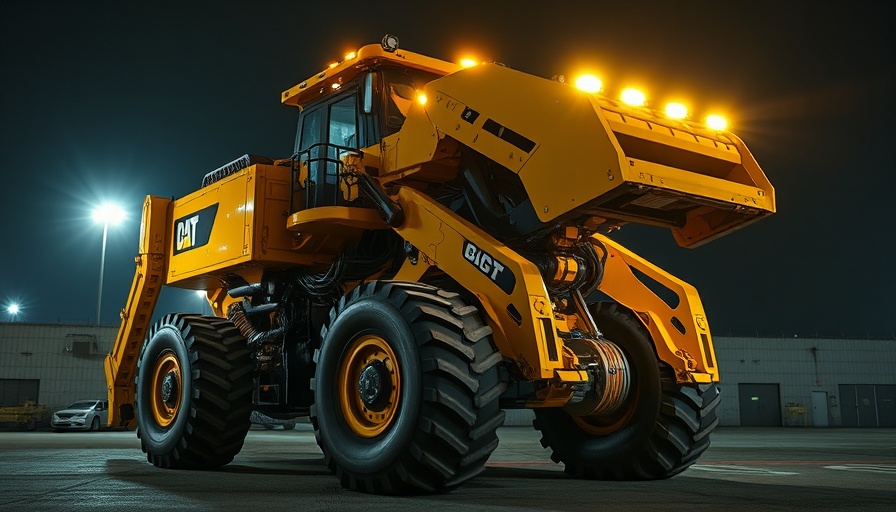
The Hollywood Dream Becomes Reality
Imagine stepping into a machine that closely resembles a design straight out of a blockbuster movie. In 1986, the “Aliens” film introduced audiences to the Cat-branded “Power Loader” exoskeleton, a combination of machinery and human ingenuity that enabled the character Ripley to battle daunting foes. Over three decades later, Hacksmith Industries brought this cinematic dream to life by creating a working version of the P-5000 Power Loader, which rests on the sturdy chassis of a Cat 239D3 compact track loader donated by Caterpillar.
From Concept to Creation
The journey to construct this ambitious project began in 2014, inspired by James Hobson, Hacksmith's founder. His goal was not merely to replicate a beloved movie prop but to forge a functional piece of machinery that could crush cars at robot competitions, mesmerizing over 15 million subscribers on YouTube. After three years of meticulous work, the Power Loader emerged, exhibiting remarkable capabilities. With the hydraulic power unit generating robust support, this impressive machine can lift up to 7,200 pounds and reach speeds of 7.5 mph.
The Power Element
The heart of the Power Loader lies in its Cat compact track loader base, equipped with a 67-horsepower hydraulic system that engineers utilized expertly. The loader delivers an impressive 26 gallons per minute of hydraulic flow at 3,000 psi, which powers the manipulative arms, controlled manually or via remote.
Engineering Excellence Unveiled
Using cutting-edge engineering techniques, the Hacksmith team connected plasma-cut steel sections in a tab-and-slot design before welding them into the final structure. The results not only evoke the futuristic design but also embody the robustness required for intensive tasks, blending entertainment with engineering prowess.
The Broader Implications of Exoskeleton Technologies
While Hacksmith's venture started as a spectacle, it underscores vital discussions surrounding the practical applications of exoskeletons. According to projections from ABI Research, the industry is expected to surge from $68 million in 2014 to a staggering $7.3 billion by 2030. This indicates an acceleration in development and acceptance of exoskeletons, not just for entertainment but also in arenas like construction, healthcare, and logistics, assisting workers with challenging physical tasks.
Real-Life Applications and Benefits
As the market for exoskeleton technology evolves, the benefits for industries become increasingly evident. Many workers face challenges like fatigue and chronic injury due to demanding physical labor. With the introduction of systems designed to lift heavy loads and relieve pressure, exoskeletons stand to revolutionize how sectors like manufacturing and construction operate. This technology may significantly reduce injury rates, leading to a healthier workforce and increased productivity.
Inspirations and Innovations Inspiring Future Engineers
The impact of projects like the Hacksmith Power Loader extends well beyond construction sites. This engineering marvel serves as a creative inspiration for young innovators and aspiring engineers who are captivated by the combination of fantasy and reality. As the next generation of problem solvers becomes increasingly attracted to engineering fields, such innovative projects pique their interest and nurture their ambitions.
Future Predictions for Exoskeleton Use
In addition to the enjoyable spectacle of movies, it seems exoskeletons are set to take our lives by storm. As technology progresses, manufacturers keep exploring ways to integrate exoskeleton systems into everyday tasks, from assisting workers in warehouse settings to aiding medical professionals in rehabilitating patients. The future of exoskeletons looks bright, promising advancements in both functionality and accessibility in various contexts.
Wrapping Up: Join the Adventure!
The Hacksmith's adventure of turning Hollywood dreams into reality is a testament to the world of possibilities in engineering and technology. As exoskeleton technology edges toward mainstream acceptance, it is essential for contractors, engineers, and technology enthusiasts alike to stay informed on the innovations reshaping industries. Interested in learning more about cutting-edge technologies or enhancing your own engineering skills? Visit ProHomeGuides for expert insights and opportunities in the home service marketplace, and pave your path to technological mastery.
 Add Row
Add Row  Add
Add 




Write A Comment